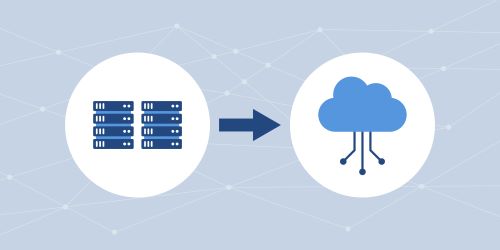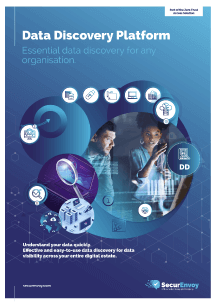

5 steps to understand if your data is ready for on-premise to cloud migration
The benefits of moving to the cloud are well-known. Migrating to the cloud can help with faster implementations, flexibility, cost efficiencies, improved collaboration and access from anywhere. But, moving to the cloud can also provide other challenges. While it can make it easier for customers and employees to use and input information, at the same time it brings with it increased amounts of data to manage and applications in the cloud that are holding sensitive data.
The data management challenges you have with your on-premise applications and data don’t disappear once your applications are in the cloud. While your cloud provider is responsible for infrastructure and operating system security, you are still responsible for the integrity and security of your data.
If you have completed your on-premise to cloud migration and have moved to SaaS, you may still need to ensure that you have visibility of your sensitive data there as well as in other on-premise applications. Managing sensitive on-premise and cloud data together increases the challenge. Knowing what data you have in the cloud and on-premise (ready for cloud migration) is key.
If you haven’t migrated already and are planning to move your data to the cloud, it is important to understand the data you have, the data risk profile and how those risks can be managed before you start on the data migration process and your journey to the cloud.
Are you ready for on-premise to cloud migration?
We’ll take a look at some of the ways in which you can understand if your data is ready for on-premise to cloud migration and the tools you can use to ease the data migration process. But, before we do, let’s take a brief step back and look at some fundamentals of cloud migration including the benefits of this strategy and the challenges you should address before you migrate your data.
What is cloud migration?
Simply put, “Cloud Migration” is the process of moving data, applications and other IT services to the cloud, whether on-premise to cloud migration or from one cloud to another.
You will probably have also been evaluating some of the following benefits of moving your applications and data to the cloud.
The benefits of on-premise to cloud migration
- Flexibility and scalability – you can support a higher number of users, more easily, without the need to set up and buy additional physical servers and storage – so you can scale up as your business evolves.
- Improve performance and end-user experience – applications hosted in the cloud can be scaled easily to serve more users or customers as needs dictate.
- Control/Lower costs – by moving to a subscription model (OPEX) rather than CAPEX it is easier to predict and control costs over time. Hardware and operational costs might be reduced with fewer server upgrades and managed services so you can re-divert IT expertise to other areas.
- Accessibility – ensuring your data is accessible from anywhere for customers and employees. The pandemic was a catalyst for cloud migration encompassing newly remote workers and improving their user experience.
For any on-premise to cloud migration project to be successful, it needs careful preparation and planning. Data migration is just one aspect of the whole cloud migration process and data security and compliance are often seen as obstacles. Whether you have decided to lift and shift your existing application or drop your existing on-premise application and shop for a new cloud solution, IT and business stakeholders should work together from the outset to profile and identify data before the migration takes place.
What is data migration?
The definition of data migration includes moving data between locations (on-premise to cloud, server to server) or systems. It also includes data profiling, data cleansing, data validation and quality assurance.
Over time the data in the application you want to migrate might become outdated or incorrect. Data owners may have changed. So, having a solid data migration process in place as part of your cloud migration strategy is a must. Every migration will differ, but there are steps you can take to ensure that it is successful.
Optimise the data migration process
- Identify key stakeholders in the business who are responsible for sensitive data and compliance, such as data owners and IT, and who need to be involved in the data migration project.
- Understand what data you have and in which applications it resides. Remember some sensitive data might be held in collaboration software, as well as structured data in databases and standard applications.
- Profile your data. Understand the significance of the data, its risk profile as well as the data quality.
Understanding and preparing the data you have now, will save time later in the data migration process.
5 steps to understand if your data is ready for on-premise to cloud migration
Let us assume you are migrating one application. Take Atlassian for example. Traditionally it has been very hard to identify and discover sensitive data on-premise in collaborative environments. Typically, in order to understand the data you have, you had to do this manually which takes a lot of time and effort. But there are tools and tips to help you in this process.
First, let’s take a look at the steps you need to take to understand if your data is cloud ready.
- Understand what on-premise data you currently have. Your sensitive data might be located anywhere across the organisation – on different servers, in different applications and data repositories, and it may have worked its way onto USBs, external drives and other endpoints.
Even when your data is on-premise, from a data compliance and regulatory standpoint, understanding what sensitive data you have and where it is located can ensure that your business is compliant and improve data protection…even before you start migrating it to the cloud. Understanding the data you have is key. - Understand what data you need. Profiling your data, i.e. what is sensitive and what is not is an important step in on-premise to cloud migration, and can help in determining what data you will actually migrate to the cloud as part of the data migration process. From a security perspective, it could be that you have some data that needs to remain on-premise and other less sensitive data that can be moved.
- Identify the data and profile it by data type, location and sensitivity. This classification of your data will allow further management of the data as required.
- Clean up any data that is not needed. In identifying the data you have, you may come across duplicate or incorrect records, so it is also a good opportunity to cleanse data before the data migration process starts. Cleansing your data and reducing the amount of data helps you to avoid paying for any data in the cloud that you don’t need to and helps you realise better cost efficiencies.
- Review regulatory compliance. Understanding the risk profile of your data will help you to plan for what data is locked down and different levels of user access once it is migrated.
Post cloud migration – managing data in the cloud
Once you have completed your cloud migration, you will need to monitor your data, in the cloud as well as in other applications you might still have on-premise. The requirement to understand your data is an ongoing task.
Using data discovery tools to assist the data migration process
Data Discovery is all about understanding your data. Managing sensitive data and owning the data risk is always a challenge, wherever it is located Whether that be in the cloud, on-premise or in different types of applications. Data discovery tools help you manage data wherever you need it and assist you in completing the “5 steps to understand if your data is ready for on-premise to cloud migration”. Forget the manual process. With a data discovery tool you will have one solution to manage data, wherever you need it.
How SecurEnvoy Data Discovery Can Help
SecurEnvoy Data Discovery is a fast to deploy and easy to use data discovery tool which complements a cloud or hybrid-cloud strategy.
SecurEnvoy Data Discovery can be used as the first step in understanding the sensitive data you have on premise, across your entire digital estate (servers, laptops, network shares, on-premise and cloud solutions) and then used to track data once it has been moved to the cloud or other storage.
Find out more about SecurEnvoy’s Data Discovery
Published: 6 February 2024
Category: Industry Research
![]()
Data Discovery
Platform
(DD)
Data discovery across your digital estate.
Essential data discovery for any organisation.
Learn more about SecurEnvoy DD
Hear more from
our security
experts






